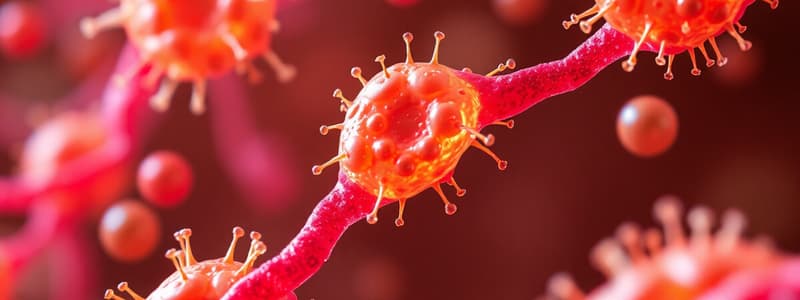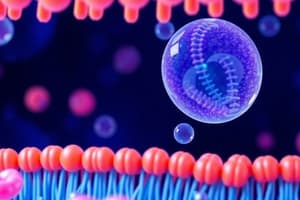Podcast
Questions and Answers
What is the primary function of the cell membrane?
What is the primary function of the cell membrane?
- To produce energy for the cell
- To synthesize proteins
- To contain the cell's DNA
- To serve as the outer boundary of the cell and regulate transport (correct)
Which of the following distinguishes a eukaryotic cell from a prokaryotic cell?
Which of the following distinguishes a eukaryotic cell from a prokaryotic cell?
- Ability to replicate
- Presence of cytoplasm
- Presence of a cell membrane
- Presence of a true nucleus and other membrane-enclosed structures (correct)
What is the primary function of the nucleus?
What is the primary function of the nucleus?
- Energy production
- Storage and processing of the cell's information (DNA) (correct)
- Lipid production
- Protein synthesis
Which of the following best describes the structure of a cell membrane?
Which of the following best describes the structure of a cell membrane?
What part of the cell is the primary site for many biochemical processes such as glucose metabolism and protein synthesis?
What part of the cell is the primary site for many biochemical processes such as glucose metabolism and protein synthesis?
What role do proteins play in the cell membrane?
What role do proteins play in the cell membrane?
What is the primary function of the mitochondria?
What is the primary function of the mitochondria?
The rough endoplasmic reticulum is characterized by which of the following?
The rough endoplasmic reticulum is characterized by which of the following?
Which structure is responsible for organizing the cytoplasm?
Which structure is responsible for organizing the cytoplasm?
What is the function of the nuclear pores found in the nucleus?
What is the function of the nuclear pores found in the nucleus?
Flashcards
What is a cell?
What is a cell?
The basic unit of life, responsible for growth, replication, and interaction with other cells.
What are prokaryotic cells?
What are prokaryotic cells?
A cell without a nucleus or membrane-bound organelles.
What are eukaryotic cells?
What are eukaryotic cells?
A cell with a true nucleus and membrane-bound organelles.
What is the cell membrane?
What is the cell membrane?
Signup and view all the flashcards
What is the cytoplasm?
What is the cytoplasm?
Signup and view all the flashcards
What is a semipermeable membrane?
What is a semipermeable membrane?
Signup and view all the flashcards
What is the nucleus?
What is the nucleus?
Signup and view all the flashcards
What are mitochondria?
What are mitochondria?
Signup and view all the flashcards
What is the endoplasmic reticulum?
What is the endoplasmic reticulum?
Signup and view all the flashcards
What is the Golgi apparatus?
What is the Golgi apparatus?
Signup and view all the flashcards
Study Notes
Biochemistry and the Unity of Life
- Cells are the basic unit of life
- Organisms can be single-celled or multicellular
- Cells grow, replicate, and interact with each other
Learning Objectives
- Differentiate between prokaryotic and eukaryotic cells
- Describe the structure and function of the two main parts of a cell: the cell membrane and cytoplasm
- Describe the structure and function of organelles including the nucleus, mitochondria, endoplasmic reticulum, and Golgi apparatus
1.4 Membranes Define the Cell and Carry Out Cellular Functions
- Basic unit of life is the cell
- Cells grow, replicate, and interact
- Two types of cells
- Prokaryotic - lack a nucleus and membrane-bound organelles
- Eukaryotic - have a nucleus and membrane-bound organelles
- Two parts of a cell (regardless of type)
- Cell membrane - outer boundary of the cell
- Phospholipid bilayer
- Phosphate heads are hydrophilic (water-loving), facing outward
- Fatty acid tails are hydrophobic (water-fearing), facing inward
- Cytoplasm - intracellular material within the membrane, chemically different from the external environment.
- Phospholipid bilayer
- Cell membrane - outer boundary of the cell
- Semipermeable membrane – allows some things to cross, but not others
- Phospholipids primarily allow very small and hydrophobic substances to cross the membrane, while proteins facilitate the transport of larger, hydrophilic substances.
- Cytoplasm is the fluid inside the cell, where many biochemical processes occur including glucose metabolism, fatty acid synthesis, and protein synthesis
- Cytoplasm is organized by the cytoskeleton consisting of
- Actin filaments
- Intermediate filaments
- Microtubules
Organelles Important in Biochemistry
- Nucleus - double-membraned organelle with nuclear pores, houses DNA and is the information center of the cell
- Mitochondria - double-membraned, inner membrane highly folded (cristae) - Intermembrane space between the membranes - Mitochondrial matrix inside the inner membrane - Produces most energy used by the cell
- Endoplasmic Reticulum (ER)
- Network of membranous sacs
- Two types
- Rough ER - studded with ribosomes; synthesizes proteins that will be inserted into or secreted from the cell, and modifies/folds these proteins
- Smooth ER - processes exogenous chemicals; synthesizes lipids
- Golgi complex - receives vesicles containing proteins from the rough ER, further processes proteins, adds carbohydrates, packages proteins in vesicles, and sends them to their target locations .
Studying That Suits You
Use AI to generate personalized quizzes and flashcards to suit your learning preferences.




